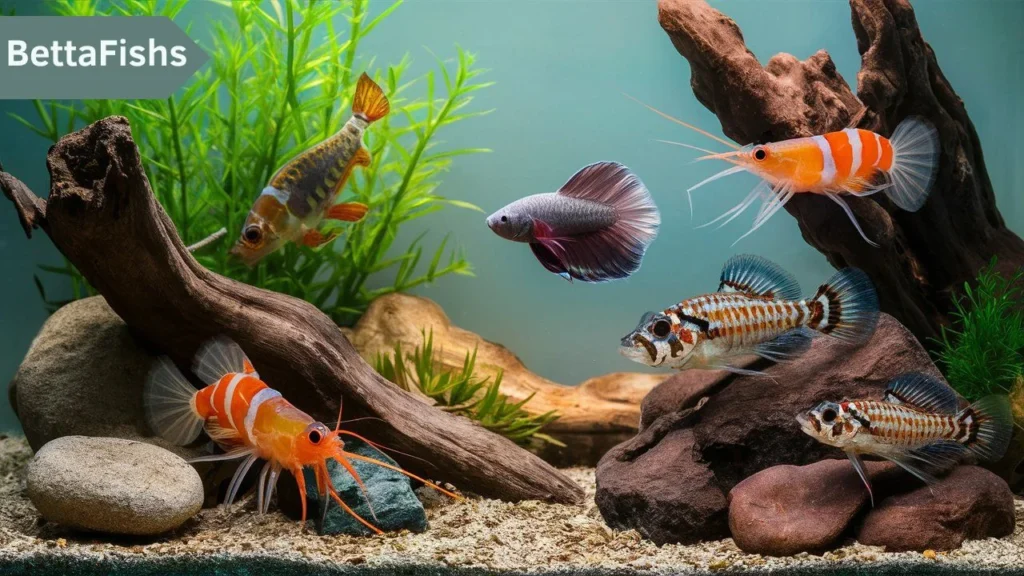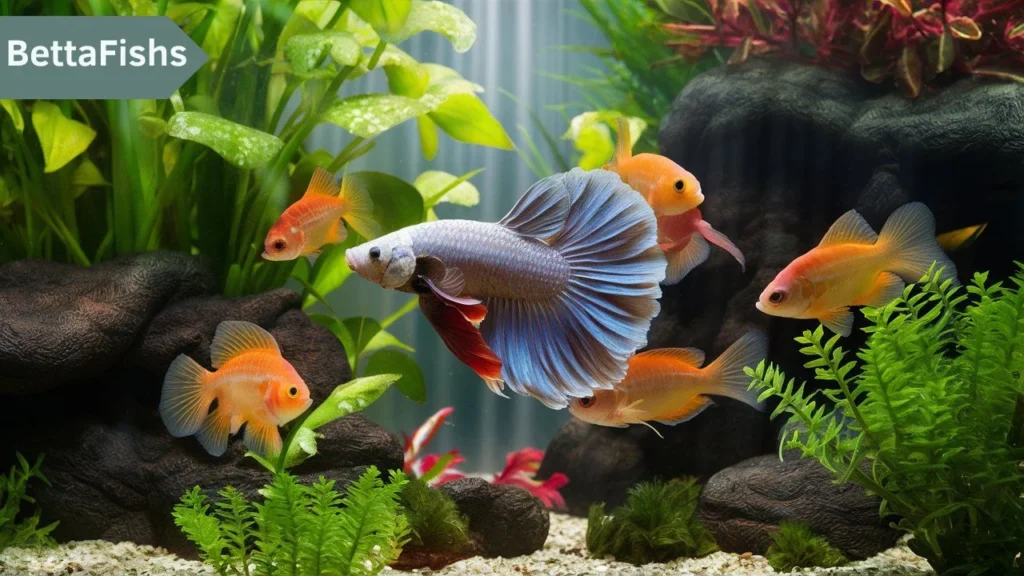When you think of Betta fish, you might imagine a solitary, colorful creature that doesn’t play well with others. While this reputation holds some truth for male Bettas, female Betta fish can be more social and can thrive with the right tank mates. In this guide, we’ll explore how to create a harmonious community in your aquarium by choosing the best tank mates for your female Betta fish.
Temperament of Female Bettas
Female Betta fish, also known as Siamese fighting fish, are known for their vibrant colors and unique personalities. Unlike their male counterparts, female Bettas tend to be less aggressive, making them more suitable for community tanks.
However, they still possess a hierarchy and can display territorial behavior, especially if they feel threatened.
Differences Between Male and Female Bettas
Male Bettas are infamous for their aggressive nature and are often kept alone. Female Bettas, on the other hand, can coexist with other fish, but this depends heavily on their individual temperament and the environment provided. Males typically have longer fins and more vivid colors, while females have shorter fins and are generally smaller. Understanding these differences is crucial when considering tank mates for your female Betta.
Why Consider Tank Mates for Female Bettas?
Benefits of a Community Tank
Adding tank mates to a female Betta’s environment can create a more dynamic and visually appealing tank. It also helps to reduce stress and boredom for the Betta, as they have more interaction and stimulation. A well-balanced community tank can mimic the natural ecosystem, providing a healthier and more enriching environment for all inhabitants.
Factors to Consider Before Adding Tank Mates
Before adding any tank mates, it’s essential to evaluate the current setup and the temperament of your female Betta. Key factors to consider include the tank size, water conditions, and the compatibility of potential tank mates. A peaceful and balanced community requires careful planning and observation.
Ideal Tank Setup for Female Bettas
Tank Size and Environment
For a community tank, a minimum of 10 gallons is recommended, but 20 gallons or more is ideal. This allows enough space for the Betta and her tank mates to establish their territories and reduces the likelihood of conflicts. A well-planted tank with hiding spots will help create a more secure and stress-free environment for your Betta.
Plants and Decorations for a Peaceful Habitat
Live plants like Anubias, Java Fern, and Amazon Swords not only enhance the aesthetic appeal of the tank but also provide essential hiding spots for your Betta and her tank mates. Decorations such as caves, rocks, and driftwood offer additional shelter and help to break the line of sight, reducing potential aggression.
Water Parameters and Maintenance
Maintaining stable water parameters is crucial for the health of your Betta and her tank mates. The water temperature should be kept between 76°F and 82°F, with a pH level between 6.5 and 7.5. Regular water changes and a good filtration system will help maintain water quality and prevent the buildup of harmful toxins.

Best Tank Mates for Female Betta Fish
Peaceful Community Fish
When selecting tank mates, opt for peaceful species that won’t provoke or outcompete your Betta. Some suitable options include:
- Corydoras Catfish: These bottom dwellers are peaceful and won’t intrude on your Betta’s territory.
- Neon Tetras: Small, schooling fish that add color and activity without causing stress to the Betta.
- Harlequin Rasboras: Another small, peaceful schooling fish that coexists well with Bettas.
Bottom Dwellers
Bottom dwellers like Corydoras and Kuhli Loaches are excellent tank mates for female Bettas as they occupy different levels of the tank and are generally non-aggressive. They help keep the substrate clean and don’t compete for the same space as the Betta.
Snails and Shrimp
Invertebrates such as Mystery Snails and Amano Shrimp can be great additions to a Betta tank. They help with algae control and are unlikely to provoke the Betta. However, it’s essential to monitor the Betta’s behavior, as some may view shrimp as prey.
Schooling Fish
Schooling fish like Neon Tetras and Harlequin Rasboras are excellent choices because they stick together, reducing the chances of individual fish being targeted by the Betta. Their fast and erratic swimming patterns can also deter the Betta from displaying aggression.
Tank Mates to Avoid
Aggressive or Territorial Species
Avoid adding fish that are known for their aggression or territorial behavior, such as certain species of Cichlids or Tiger Barbs. These fish can trigger aggression in your Betta, leading to stress and potential injury.
Fast Swimmers or Fin Nippers
Fast swimmers and fin nippers, like Serpae Tetras or Barbs, can stress your Betta by constantly chasing or nipping at their fins. This can lead to injury and increased aggression, disrupting the harmony of the tank.
How to Introduce Tank Mates to Female Bettas
Quarantine and Health Checks
Before introducing new fish, it’s crucial to quarantine them for at least two weeks to ensure they are free of diseases or parasites. This step helps protect your Betta and other tank inhabitants from potential health issues.
Gradual Introduction Process
When adding new tank mates, it’s best to introduce them gradually. Start by rearranging the tank decorations to break up established territories. Then, add the new fish during feeding time, as this can distract the Betta and reduce initial aggression.
Monitoring Behavior and Adjustments
After introducing new tank mates, closely monitor your Betta’s behavior. Aggression might be indicated by behaviors including flaring, pursuing, or biting., or biting. If any conflicts arise, consider removing the tank mate or providing additional hiding spots to reduce stress.
Managing Aggression and Conflicts
Recognizing Signs of Aggression
Signs of aggression in Bettas include flaring fins, chasing, and biting. If you notice these behaviors, it’s essential to intervene quickly to prevent injury and stress.
Steps to Take if Conflicts Arise
If conflicts arise, consider separating the fish using a tank divider or relocating the aggressive tank mate. Providing more hiding spots or rearranging the tank can also help reduce territorial disputes.
When to Remove a Tank Mate
If aggressive behavior persists despite your best efforts, it may be necessary to remove the tank mate. It’s essential to prioritize the well-being of all fish in the tank and ensure a peaceful environment.
Feeding a Community Tank
Dietary Needs of Female Bettas
Female Bettas are carnivorous and thrive on a diet of high-quality Betta pellets, frozen or live foods like bloodworms, and brine shrimp. Ensure that the diet is varied to meet their nutritional needs.
Feeding Strategies for a Mixed Community
When feeding a community tank, it’s important to ensure that all fish get their fair share of food. Distribute food evenly across the tank and consider using sinking pellets or wafers for bottom dwellers. Refrain from overfeeding as this can result in unclean water.

Common Myths About Female Betta Fish
Myth: Female Bettas Are Always Peaceful
While female Bettas are generally less aggressive than males, they can still display territorial behavior, especially in crowded or stressful environments. It’s essential to monitor their behavior and ensure they have enough space and hiding spots.
Myth: Female Bettas Can’t Live with Other Fish
Female Bettas can live with other fish, but it’s crucial to choose compatible tank mates and provide the right environment. Not all fish are suitable companions, so careful selection is key to a harmonious community.
Conclusion
Creating a peaceful and thriving community tank with female Betta fish requires careful planning, the right tank mates, and diligent monitoring. By understanding the temperament of your Betta and choosing compatible species, you can enjoy a vibrant and dynamic aquarium that benefits all its inhabitants.
FAQs
Can Female Bettas Live with Male Bettas?
In general, it’s not recommended to keep male and female Bettas together in the same tank unless for breeding purposes under controlled conditions. They can become aggressive towards each other, leading to stress and potential harm.
How Many Female Bettas Can Live Together?
A group of 4-6 female Bettas, known as a “sorority,” can live together in a sufficiently large tank (20 gallons or more). However, it’s essential to monitor them closely for any signs of aggression and provide ample hiding spots.
What Is the Best Tank Size for Female Bettas with Tank Mates?
A tank of at least 20 gallons is recommended when keeping female Bettas with tank mates. This provides enough space for all inhabitants to establish their territories and reduces the likelihood of conflicts.
How Do I Know If My Female Betta Is Happy?
Signs of a happy Betta include vibrant colors, active swimming, regular eating, and bubble nest building. A peaceful interaction with tank mates and a lack of stress-related behaviors like fin clamping are also good indicators.
Can Female Bettas Live with Guppies?
Guppies can be a risky choice as tank mates for female Bettas. Their long, flowing tails may provoke fin-nipping behavior from the Betta. If you choose to keep them together, closely monitor their interactions.





One Comment
Leave a ReplyOne Ping
Pingback:Tank Mates for Betta Fish